Whew! Two days of discussing a very challenging and thorny subject. http://techcampphnompenh.wordpress.com
It was not all work, though.
Summary: The US Embassy in Phnom Penh deserves kudos for simply getting this diverse crew all in the same room, and kicking off discussions on trafficking and technology. Many have different philosophies and methodologies. Many of the tech folks were new to the issue of trafficking. This is just a start of what should be a much larger and inclusive discussion.
————–
Pre-Camp:
I was presenting on two subjects: anti-trafficking law, and how to combat ‘pushback’ that most human rights organizations can get. At our pre-camp orientation, many of the ‘usual suspects’ for techcamps and BarCamps were there – Be Chantra, Samdy Lonh, Anirudh Singh, folks from INSTEDD and Open Institute. I noted that most participants were focused on one organization or one area of technology.
(For example, Friends International was helping me out with sourcing Anti-Trafficking guidelines, and have very strong opinions on media exposure for trafficked / underage individuals). We are asked to prepare our presentations to do a ‘mind map’ to articulate the topic visually. That was a little different.
I spent the few days prior to the camp sweating my presentations. I had two that didn’t quite flow into one simple direction, but I was happy to do them, and felt both were really needed for this audience.
1. Why a talk on law? I’ve seen some pretty bad representations of Cambodian trafficking issues in the media. And rather than point the finger, I thought I’d take it back to first principles and review the laws and guidelines that should be followed.
I sourced illustrations from Prum Vannak, an artist who had previously been trafficked on a fishing boat, and now is working on a graphic novel about his experiences. Since he currently lives in Pursat, we had to describe what we needed and get them a parcel sent by bus.
2. The ‘pushback’ presentation was primarily interactive, showing some examples about how every web site and email has a digital fingerprint. Both presentations took some homework.
Day One:
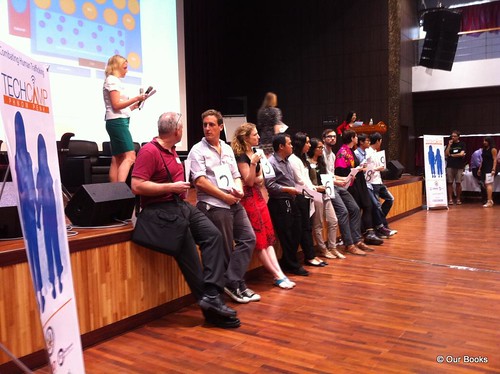
I had a launch for Indochina Starfish‘s ‘Sexual Reproductive Health’ teaching curriculum that day, so I missed the kickoff of the event. I was able to get ISF’s Director Kate to come along to scope out TechCamp, I was particularly keen to see them engage with the IT community in Phnom Penh. They take a very strong line on child protection and were also a source for some of my talking points. We arrived at the venue (Royal University of Phnom Penh) at about 10am.
I was pretty impressed by the wide range of participants. There were quite a few from other countries, this was a regional meeting and was discussing long-term, regional and global technical solutions to Trafficking issues.
We landed during the ‘speed geeking’ session, and I was very pleased to see the Open Development Cambodia crowd there, as well as Urban Voice. It’s a great feeling to see those sites ticking along on their own after months/years of development work. I was particularly intrigued by the topic of crowd-funding.
Anirudh and Kounila had also arrived late. At BarCamps people come and go as they please so I think that the structure of a TechCamp takes a little adjustment for some of us – I know it does for me. Accordingly, some of their sessions had been revised or deleted in the schedule.
There were then some presentations where organizations discussed their current use of technology to solve problems. It was time for OpenDevCam and other groups to shine. I was very intrigued by Chabdai coalition’s work with the soon-to-launch ‘Freedom Registry‘.
After a lunch catered by Hagar - “It’s *halal*” we were told with smiles – it was finally time to sink my teeth into my talk on ‘Laws’. I was lucky to have a good group.
The presentation file is above, and I did my best to work with them to create a ‘Mind Map’ as requested for the issue.
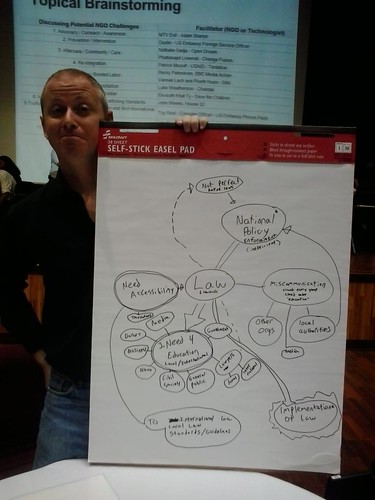
Our coffee break was sans coffee… I’m sure this qualifies as a #FirstWorldProblem. Still, I wish I’d known there was a student canteen hidden around the corner where I could have caffeinated myself.
We then broke into focus groups discussing varied anti-trafficking topics, articulating issues to be addressed with technological solutions the following day.
In the afternoon, I spotted a familiar face – ‘NN‘ (Mekong ICT Camp alumni) had joined! It was such a big meeting that it’s easy to miss faces and folks. I resolved to get her some Open Comics goodies to take back to Myanmar.
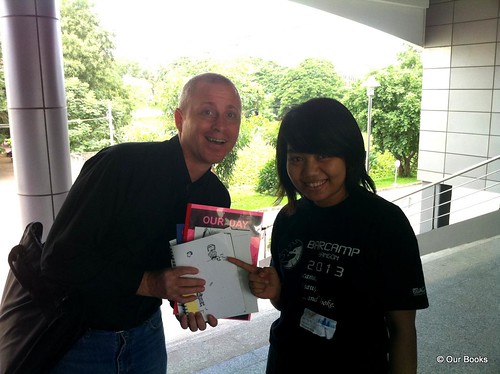
Once we were near closing, had some fried bread with what tasted like some kind of meat paste – a Khmer treat I love that’s probably bad for my blood pressure, cholesterol and goodness knows what else. (That’s Cambodian cooking though; there’s nothing that can’t be improved without a little pork. My very first Khmer teacher cooked it for our class in the States, eons ago for me now.

(Now that I’ve actually asked my khmer friends what the name is of this food, there’s an intense discussion about whether this food is ‘really Khmer’ and what was in it. Stay tuned. It might be halal after all.)
And we had coffee! Luke (Chabdai) and I could not restrain ourselves from expressing our gratitude.
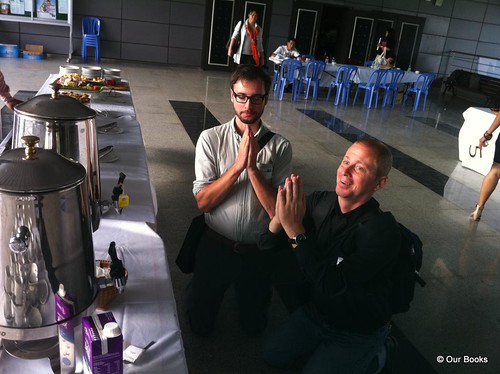
As I headed back home I reflected on two items that I’m still digesting:
There was a large contingent of faith-based groups there were at the Camp. I would really be interested to see their charters and methodologies. There seems to be something about trafficking that draws Christians to work in ‘front line’ roles, in particular the always-controversial area of rescue and prevention. I might speculate that in Cambodia, the majority of shelters and reintegration facilities may very well be dominated by Christian groups.
Secondly, as an event run by the US Embassy, TechCamp naturally takes some cues from overall government policy. If it had been held during the Bush Administration, I doubt Marie Stopes (which has access to abortion information as a key area of focus) would have been invited. And one set of voices that was not there was that of sex workers – invoked in discussion but not represented as groups or individuals. Two items for pundits and theorists to chew on, there.
Day Two:
Managed to get to the venue on time this day.
Started off the day with my brief talk on ‘Pushback’ (Tips: be proactive, and keep in mind every email and web site has a digital ‘fingerprint’.)
We then headed right into groups. Our goal: pair ‘technologists’ with affinity groups from NGOs and find technical solutions to pitch for the closing session.
While my favored area is ‘Storytelling’ , I decided to sit in on the ‘CrowdFunding’ presentation, a topic I wanted to learn more about.
Then, just before the break for lunch, the TechCamp Team did a little presentation celebrating Prum Vannak‘s work. I hadn’t spotted him on the first day, serves me right for arriving late! It turns out that in addition to his upcoming graphic novel, BBC Media Action is working on a documentary about him, and a tiny portion of an animation segment was screened.
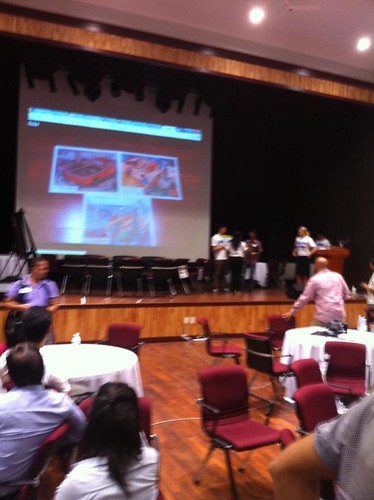
Vannak was with the storytelling group! I joined him for lunch and jumped ship for the storytelling group. If there was going to be comics, that’s where I belong. I said my farewells to the Crowdfunding group and moved my gear to the other session.
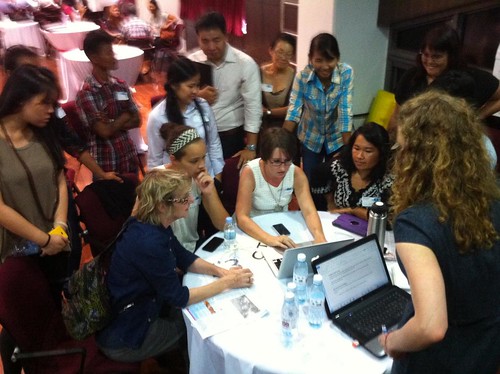
The rest of the afternoon was spent coming up with pitches, and there were some small prizes in the offing as well as potential funding from the McCain Foundation. (I actually had no idea there was one.)
During one of the breaks I caught up with NN and another visitor from Burma, and hopefully we’ll continue to network on how to get some Open Comics over to Burma. (Turns out our draft Burmese translation is far from perfect.)

I could see that the TechCamp team darting from group to group, checking in, keeping the process going, quite keen to see some good, workable presentations. If I’d been a one issue, one theme person, this process would have worked a lot better for me. And there was a huge diversity in personal and technical viewpoints. ‘Herding cats’ is really a poor metaphor to apply. Regardless, the groups gave it their all.
The result was some interesting (and often quite humorous) presentations by assemblages you’d rarely find rubbing shoulders.
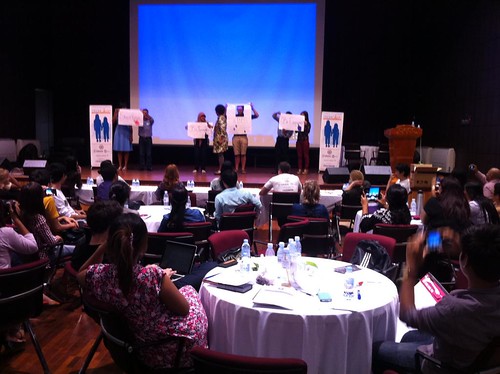
(Live action web sites? Check, above. ‘Gamification‘? Check) Each group took their turn and eventually two groups (not mine) took home some prizes.
Will they get funding? I have a hunch that is being chewed over right now.
After the obligatory group shot, cards were exchanged, farewells said – and a heavy rain hit.
Hope everyone made it back OK!
Plenty to reflect on from these two days.
(I’ve written this post pretty hastily and will add pictures, more names, references to it shortly.)



























